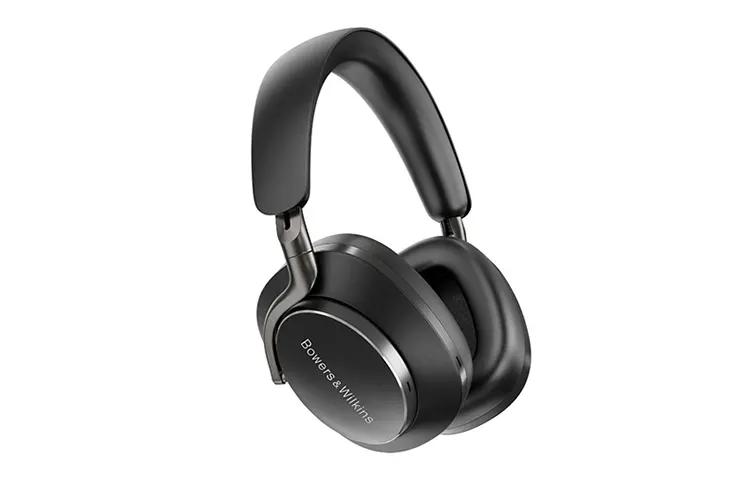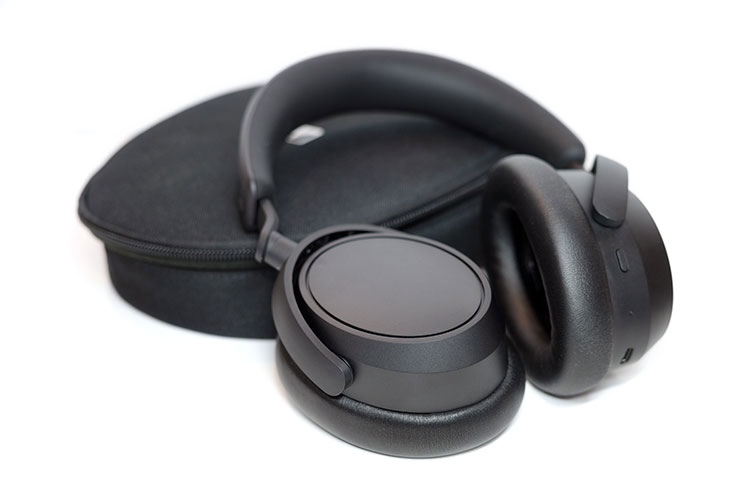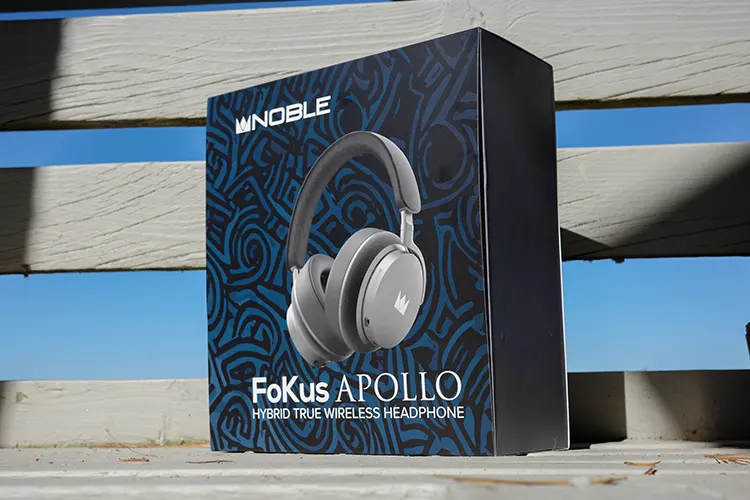Select Comparisons
B&W Px8
Technical
Sporting a single 40mm dynamic driver made with carbon for rigidity, the Px8 has four microphones for ANC use and two for cellular use.
Widely regarded as having if not the best, the second-best ANC currently out there, the use of such technology is a telling trademark of B&W products.
The Px8 also decodes all the latest codecs but is a bit harder to drive than the Apollo. Use with USB-C or 3.5mm single-ended cables is also the same.
With a much shorter battery life of 30 hours (ANC on), the Px8 cannot touch the Noble’s 60-80 hours. This shows how quickly technology can alter battery life.

Design
There is no denying the fact that the Px8 is stunning in looks and design. The only fault I could find is with the single, thinner headband. That is until you wear the unit for long periods. Then that “fault” dissolves.
The black to me still looks the best and gives a very upscale look to the headphones. The dark gray silvery accents of the earcup, yoke, and stanchions give a luxury car feel to it. You needn’t worry about that anodization wearing either. I have had my unit for close to four years, and it still looks brand new.
The controls are not differentiated on the right cup but follow the typical play/pause in the middle with volume up above, and volume down below; making it easier to discern. I also find the reachability more efficient as well.
Performance
The Px8 remains my favorite wireless headphone up until now. Succinct lows present a bit less grunt (even with ANC on), and better control. Consequently, there is less bleed into the midrange, but also a bit less presence to the flow up the scale.
A smoother top end differs as well, and this will come down to whether you prefer a higher-reaching top or a smoother, rounded feel to the top end.
The flow across the sound spectrum is smoother on the Px8 as a result, with a natural, organic feel to it that closely follows the Harman target. I do appreciate that, but also find it lacks a bit of the “fun factor” that the Apollo has.
The ANC treatment is superb, and to be falls slightly behind the Sony below as the “next best” currently out. If you prefer a smooth, rich signature that offers a good amount of detail level to it, the Px8 might be the better choice.
If battery life and a more frontal signature also carry a fun factor to it, then the Apollo might be the better choice. Suffice it to say that Noble has reached for the top dogs in the wireless headphone market and can compete quite well based on this comparison alone.
Sony WH-1000XM5
Technical
When Sony updated to the XM5, they also decreased the driver size from 40mm to 30mm, which seems quite small until you listen to the headphones.
With lower impedance when cabled, the XM5 is quite easy to drive. This changes modestly when using the 5.2 BT mode, with a high sensitivity of 102 dB helping.
The Sony offers better battery life than the B&W but still less than the Apollo. Part of this could be the class-leading ANC technology, but the smaller size is a factor also.
The Sony will provide 30 hours with ANC on and 40 hours with ANC turned off, which is good, but starting to lag behind the current crop.

Design
Drawing a somewhat premium price, you would expect the looks and design to follow suit. The functionality certainly does, with the Sony being one of the easiest wireless headphones to “master” I have reviewed.
However, the looks are not as premium looking as the Apollo or Px8, which are both class-leading. The plastic cups also draw fingerprints like mad, making it look pedestrian well before your first break of the day.
The fit is very good, but I wish for thicker pads, which when squished will compress to the ear cup. That said, fit and feel are exceptional, and this headphone over the others has the best long-listening session comforts.
This is also the most portable of the models listed here, although the Sennheiser is coming close.
Performance
The sound coming out of the XM5 offers excellent levels of detail, with a large quantity of bass.
Bass is added a bit more through the ANC, but also promotes it less, with a lower amount of bleed into the mids. But, that bass can become quite thumpy and bloated when called upon too much. A seeming dichotomy, but with bass-rich songs it becomes too much.
The soundstage of the XM5 is very good in all dimensions, and this helps to give good space (and thus air) to the notes, which evens out the preponderance of bass. I do like the amount of bass offered, but it can be a bit much, and the iteration I have promotes more bass as compensation for the ANC technology.
The ANC technology of the XM5 is the best in class to me, and worth that extra bit of bass. Subsequent iterations (or firmware updates) have toned down the level of bass, making it more acceptable, and the Sony app is also one of the best.
For the price, this is an exceptional wireless headphone, and still the one to shoot for regarding ANC.
Sennheiser Accentum Plus
The Plus fixed a lot of the issues we had with the first iteration, while also raising the price a bit. To me, that increase was justified by the increased sound quality and fixing of some of those shortfalls. It is also the most economical wireless headphones compared here.
Technical
The Plus has the same 37mm dynamic driver and supports 3.5mm audio for wired connectivity as well as USB-C as the ACCENTUM. It has a BT 5.2-capable internal chipset for wireless connectivity.
The headphones are capable of receiving and decoding from SBC and AAC up to aptX, and aptX Adaptive codecs. The regular ACCENTUM uses aptX HD rather than aptX Adaptive, which supports a higher bitrate, while the latter scales more naturally depending on latency.
The hybrid ANC technology is adaptable through Sennheiser’s Smart Control app using the slider for the “hybrid effect,” but on the ear cup either ANC is on, or full transparency, there is no middle ground.
The Sennheiser ANC technology runs a close second to the Sony, tying the B&W and Bose models for “second-best ANC” out.
Sennheiser has a history of good ANC quality in their wireless options so it should be worthy of the moniker, and as good as the regular ACCENTUM. The ANC included with the Plus is a step in a different direction, much like the ACCENTUM, but a bit different in application.
Design
The ACCENTUM Plus follows Sennheiser’s subtle and understated look in most of their recent Bluetooth models. Smaller in size than the MOMENTUM 4 Wireless (but not by much), the unit only folds flat and the cups do not fold up to make the unit more portable.
The cup size is medium-small, and those with larger ears will most likely suffer from the pads lying on their ears. Stuffed with memory foam, the pads are comfortable for moderate use but have no waterproof rating.
The ACCENTUM Plus is made mostly of plastic and the headband carries over in one piece with a memory foam insert underneath for head relief.
While the fit and materials are on the budget side, they do follow the market segment. The build is quite similar to the Sony XM5, and the quality matches the Sony level as well.
That padding only goes halfway down the band in a somewhat odd shape while supporting the top of your head. Those with larger heads may find the pad/hard plastic interface could hinder comfort.
Vent slots sit on top of each cup, while two microphone holes sit on the face and side of the right cup; closer to where they are needed.
Instead of tactile buttons, there is a swipe gesturing system on the right earcup. Similar to other models, with swipe gesturing, the controls become intuitive with little effort.
Once acclimated to the functionality, I appreciated the technology and noted that this is the way many manufacturers are going currently.
Performance
While the first-gen ACCENTUM was an introductory model in this design strategy for Sennheiser, it lacked a bit of clarity. The ACCENTUM Plus deviates from this approach with a better-detailed response a bit more clarity, and tighter control of the deeper-reaching bass.
This could be construed as a more forward bass response as well, with a brighter signature adding to the perceived detail and clarity.
Dimensionally, the soundstage of the ACCENTUM Plus places instruments well, but separation suffers a bit due to the tighter dimensions of the 3D soundstage. Left and right seem a bit compressed as a result, but the layering of the instruments still carries a good definition.
Height is still the forte, with depth suffering a bit. The smooth character of Sennheiser’s tuning makes use of the space well, even with the average separation. Details come across a bit better through this soundstage than the regular model.
The Sennheiser is a very good model for the price but is outclassed by the Apollo, which would be an excellent upgrade.
My Verdict
There are some truly exceptional wireless headphones on the market right now. The B&W Px8 has a luxurious look, feel, and sound quality with excellent ANC technology. But it also has a darker signature when compared back-to-back with the Apollo.
It isn’t until you listen to both side-by-side that you realize how good the level of detail retrieval is on the FoKus Apollo.
It does have a bit less bass weight when not using the app but that slightly lifted upper midrange makes for a wonderful extension in the layering in comparison and a clarity that is hard to beat in this segment.
If I had to nitpick on anything, it would be the preponderance of bass that becomes a bit bloated on some songs. But comparatively, the Apollo delivers that low-end very well.
If you prefer using a cable, the USB-C or 4.4mm balanced jack makes the Apollo a very competent wired headphone that can compete with many of its cabled rivals. That says a lot about the tuning qualities offered in the Noble, making it one of the top wireless headphones I have tried.
The Noble FoKus Apollo is aimed at top-tier wireless headphone makers and has earned its place among them. It is an excellent-sounding set of wireless and wired ANC-capable headphones and can easily share playtime with known competitors in the top-tier wireless headphone market.
Noble FoKus Apollo Technical Specifications
- The world’s first 1x40mm dynamic driver + 14.5mm planar magnetic hybrid driver speaker arrangement
- supported codecs include LDAC, AAC, aptX, aptX HD, and SBC
- QCC3084 chip
- Integrated ADI chip combined with 3 microphones per side providing hybrid ANC with a reduction depth of up to -35db
- Bluetooth 5.3
- Superior transparency mode
- Removable boom mic
- Onboard mute switch for all microphones, including the boom mic
- Excellent call quality with or without the supplied boom mic attached
- Multipoint connection
- 80 hours of playtime without ANC / 60 hours of playtime with ANC
- Can be played with an included USB-C or 3.5mm auxiliary cable
- Compatible with Noble’s FoKus app



